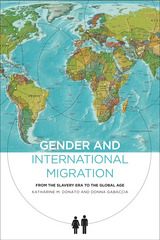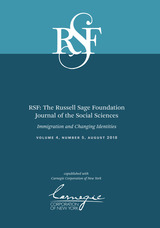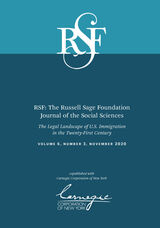3 books about Donato, Katharine M.

Gender and International Migration
KATHARINE M. DONATO is professor and chair of sociology at Vanderbilt University. DONNA GABACCIA is professor of history in the Department of Historical and Cultural Studies at the University of Toronto-Scarborough.
Russell Sage Foundation, 2015
In 2006, the United Nations reported on the “feminization” of migration, noting that the number of female migrants had doubled over the last five decades. Likewise, global awareness of issues like human trafficking and the exploitation of immigrant domestic workers has increased attention to the gender makeup of migrants. But are women really more likely to migrate today than they were in earlier times? In Gender and International Migration, sociologist and demographer Katharine Donato and historian Donna Gabaccia evaluate the historical evidence to show that women have been a significant part of migration flows for centuries. The first scholarly analysis of gender and migration over the centuries, Gender and International Migration demonstrates that variation in the gender composition of migration reflect not only the movements of women relative to men, but larger shifts in immigration policies and gender relations in the changing global economy. While most research has focused on women migrants after 1960, Donato and Gabaccia begin their analysis with the fifteenth century, when European colonization and the transatlantic slave trade led to large-scale forced migration, including the transport of prisoners and indentured servants to the Americas and Australia from Africa and Europe. Contrary to the popular conception that most of these migrants were male, the authors show that a significant portion were women. The gender composition of migrants was driven by regional labor markets and local beliefs of the sending countries. For example, while coastal ports of western Africa traded mostly male slaves to Europeans, most slaves exiting east Africa for the Middle East were women due to this region’s demand for female reproductive labor. Donato and Gabaccia show how the changing immigration policies of receiving countries affect the gender composition of global migration. Nineteenth-century immigration restrictions based on race, such as the Chinese Exclusion Act in the United States, limited male labor migration. But as these policies were replaced by regulated migration based on categories such as employment and marriage, the balance of men and women became more equal – both in large immigrant-receiving nations such as the United States, Canada, and Israel, and in nations with small immigrant populations such as South Africa, the Philippines, and Argentina. The gender composition of today’s migrants reflects a much stronger demand for female labor than in the past. The authors conclude that gender imbalance in migration is most likely to occur when coercive systems of labor recruitment exist, whether in the slave trade of the early modern era or in recent guest-worker programs. Using methods and insights from history, gender studies, demography, and other social sciences, Gender and International Migration shows that feminization is better characterized as a gradual and ongoing shift toward gender balance in migrant populations worldwide. This groundbreaking demographic and historical analysis provides an important foundation for future migration research.
[more]

RSF
The Russell Sage Foundation Journal of the Social Sciences: Immigration and Changing Identities
Kay Deaux
Russell Sage Foundation, 2018
Since the 1960s, the United States has undergone a profound demographic transformation due to increased immigration from Asia, Latin America, the Caribbean, and elsewhere. Today immigrants and their U.S.-born children represent approximately 25 percent of the population, or more than 85 million people. How has immigration changed the way that both newcomers and the native-born understand what it means to be American? This issue of RSF, edited by immigration scholars Kay Deaux, Katharine Donato, and Nancy Foner investigates how immigration has shaped the way longer-established Americans, as well as immigrants and their children, see themelves and others in terms of race, ethnicity, and national identity --- and also considers the implications for intergroup relations.
Several articles explore how immigrants negotiate their positions in the racial hierarchy and how they perceive themselves in relation to native-born groups. Michael Jones-Correa and coauthors find that while Mexican immigrants are more likely to identify as Americans the more they report positive interactions with both native-born whites and blacks, Indian immigrants’ identification with being American is largely shaped by positive interactions just with whites. Prema Kurien shows that in response to the wave of hate crimes after 9/11, Sikh Americans sought to be recognized as an American religious minority, as well as an ethnic group distinct from Indian Americans. In their study of the children of immigrants in middle adulthood, Cynthia Feliciano and Rubén G. Rumbaut find that some second-generation immigrants retain a strong attachment to an ethnic identity into their late thirties, but that ethnic identification for others wanes as their social identities as parents, workers, or spouses become more important.
Other contributors investigate the extent to which longer-established Americans respond to increased immigration. Maureen Craig and Jennifer Richeson show that whites living in areas with large or increasing racial minority populations are more likely to believe that anti-white discrimination is on the rise. Deborah Schildkraut and Satia Morotta similarly find that when millennials—particularly those who identify as white and Republican—are exposed to information on the changing racial makeup of the U.S., they express more conservative political views.
At a time when questions of immigration and national identity are at the forefront of our political and public discourse, understanding how immigrants and their offspring influence—and are influenced by—conceptions of race and identity is critical for social scientists. This issue provides key insights into the challenges of a rapidly changing population.
Several articles explore how immigrants negotiate their positions in the racial hierarchy and how they perceive themselves in relation to native-born groups. Michael Jones-Correa and coauthors find that while Mexican immigrants are more likely to identify as Americans the more they report positive interactions with both native-born whites and blacks, Indian immigrants’ identification with being American is largely shaped by positive interactions just with whites. Prema Kurien shows that in response to the wave of hate crimes after 9/11, Sikh Americans sought to be recognized as an American religious minority, as well as an ethnic group distinct from Indian Americans. In their study of the children of immigrants in middle adulthood, Cynthia Feliciano and Rubén G. Rumbaut find that some second-generation immigrants retain a strong attachment to an ethnic identity into their late thirties, but that ethnic identification for others wanes as their social identities as parents, workers, or spouses become more important.
Other contributors investigate the extent to which longer-established Americans respond to increased immigration. Maureen Craig and Jennifer Richeson show that whites living in areas with large or increasing racial minority populations are more likely to believe that anti-white discrimination is on the rise. Deborah Schildkraut and Satia Morotta similarly find that when millennials—particularly those who identify as white and Republican—are exposed to information on the changing racial makeup of the U.S., they express more conservative political views.
At a time when questions of immigration and national identity are at the forefront of our political and public discourse, understanding how immigrants and their offspring influence—and are influenced by—conceptions of race and identity is critical for social scientists. This issue provides key insights into the challenges of a rapidly changing population.
[more]

RSF
The Russell Sage Foundation Journal of the Social Sciences: The Legal Landscape of U.S. Immigration in the Twenty-First Century
Katharine M. Donato
Russell Sage Foundation, 2020
Immigration has long been viewed as both essential to American society and a polarizing political issue. Recent flashpoints around immigration include a U.S. Supreme Court decision upholding the legality of Deferred Action for Childhood Arrivals (DACA), enacted in 2012, to provide a pathway to citizenship for young, undocumented immigrants. The Trump administration has limited visas for foreign workers, banned travelers from predominantly Muslim countries, narrowed asylum-seeking procedures, and increased immigration enforcement. In this issue of RSF, edited by demographer Katharine M. Donato and economist Catalina Amuedo-Dorantes, an interdisciplinary group of scholars traces the history and contemporary landscape of legal immigration to the United States.
Donato and Amuedo-Dorantes outline American immigration policies from 1880 to the present and consider the impact of the COVID-19 pandemic on immigration. They underscore the fact that many recent immigration policies have been a result of presidential executive orders rather than legislative acts, making families and workers who enter the country without proper documentation especially vulnerable. They also examine how and why these orders are often racist and xenophobic, privileging some racial and ethnic groups and excluding others.
Contributors to the issue investigate the various ways in which immigrants secure visas, working permits, and citizenship in the United States, including through employment and family ties, as well as special statuses for military veterans, refugees, asylum seekers, and unaccompanied minors. Daniel Costa writes about how temporary migrant workers’ precarious immigration status makes them particularly likely to experience workplace abuse because they fear losing their jobs and being deported if they complain about unfair labor practices. Pia Orrenius and Madeline Zavodny consider the substantial increase in employer demand for temporary work visas, demonstrating how improved economic conditions have led to this surge, creating a viable alternative to hiring unauthorized workers. Julia Gelatt uses employment and economic data analysis to compare multiple classes of legal immigrants. Her research demonstrates that employer-sponsored immigrants are better educated, exhibit higher English proficiency, and work in more highly skilled jobs than other types of immigrants (including family-sponsored, humanitarian, and diversity visa immigrants).
Other contributors examine the experiences of immigrants with special statuses, including veterans. Cara Wong and Jonathan Bonaguro find that Americans are more likely to support a path to citizenship via military service for immigrants who entered the country with the appropriate documentation, and that many Americans believe that undocumented migrants should be barred from the military, Peace Corps, AmeriCorps and firefighting. Van C. Tran and Francisco Lara-García find little variation in early socioeconomic outcomes between refugee groups from various countries. They show that schooling and employment, along with strategic financial, community building, and other support services, are critical factors in the successful integration and improved socioeconomic outcomes of refugees. Luis Edward Tenorio finds that the patchwork of legal systems, including family, immigration, and federal courts that adjudicate the laws for children with special immigrant juvenile status, make for the uneasy and uneven integration of unaccompanied minors into key social institutions.
This issue of RSF is a timely contribution that will invigorate the field of scholarly work on the American legal immigration system.
Donato and Amuedo-Dorantes outline American immigration policies from 1880 to the present and consider the impact of the COVID-19 pandemic on immigration. They underscore the fact that many recent immigration policies have been a result of presidential executive orders rather than legislative acts, making families and workers who enter the country without proper documentation especially vulnerable. They also examine how and why these orders are often racist and xenophobic, privileging some racial and ethnic groups and excluding others.
Contributors to the issue investigate the various ways in which immigrants secure visas, working permits, and citizenship in the United States, including through employment and family ties, as well as special statuses for military veterans, refugees, asylum seekers, and unaccompanied minors. Daniel Costa writes about how temporary migrant workers’ precarious immigration status makes them particularly likely to experience workplace abuse because they fear losing their jobs and being deported if they complain about unfair labor practices. Pia Orrenius and Madeline Zavodny consider the substantial increase in employer demand for temporary work visas, demonstrating how improved economic conditions have led to this surge, creating a viable alternative to hiring unauthorized workers. Julia Gelatt uses employment and economic data analysis to compare multiple classes of legal immigrants. Her research demonstrates that employer-sponsored immigrants are better educated, exhibit higher English proficiency, and work in more highly skilled jobs than other types of immigrants (including family-sponsored, humanitarian, and diversity visa immigrants).
Other contributors examine the experiences of immigrants with special statuses, including veterans. Cara Wong and Jonathan Bonaguro find that Americans are more likely to support a path to citizenship via military service for immigrants who entered the country with the appropriate documentation, and that many Americans believe that undocumented migrants should be barred from the military, Peace Corps, AmeriCorps and firefighting. Van C. Tran and Francisco Lara-García find little variation in early socioeconomic outcomes between refugee groups from various countries. They show that schooling and employment, along with strategic financial, community building, and other support services, are critical factors in the successful integration and improved socioeconomic outcomes of refugees. Luis Edward Tenorio finds that the patchwork of legal systems, including family, immigration, and federal courts that adjudicate the laws for children with special immigrant juvenile status, make for the uneasy and uneven integration of unaccompanied minors into key social institutions.
This issue of RSF is a timely contribution that will invigorate the field of scholarly work on the American legal immigration system.
[more]
READERS
Browse our collection.
PUBLISHERS
See BiblioVault's publisher services.
STUDENT SERVICES
Files for college accessibility offices.
UChicago Accessibility Resources
home | accessibility | search | about | contact us
BiblioVault ® 2001 - 2024
The University of Chicago Press









